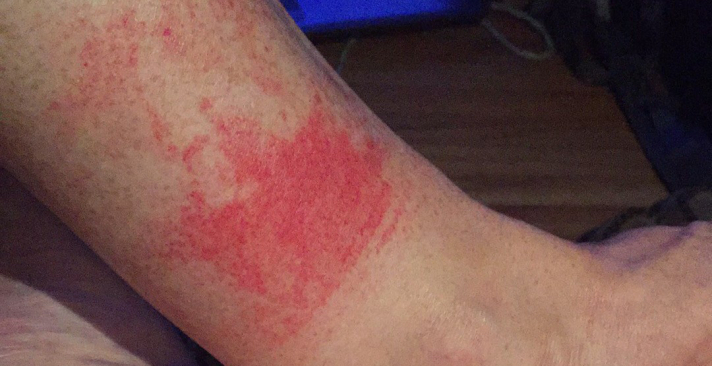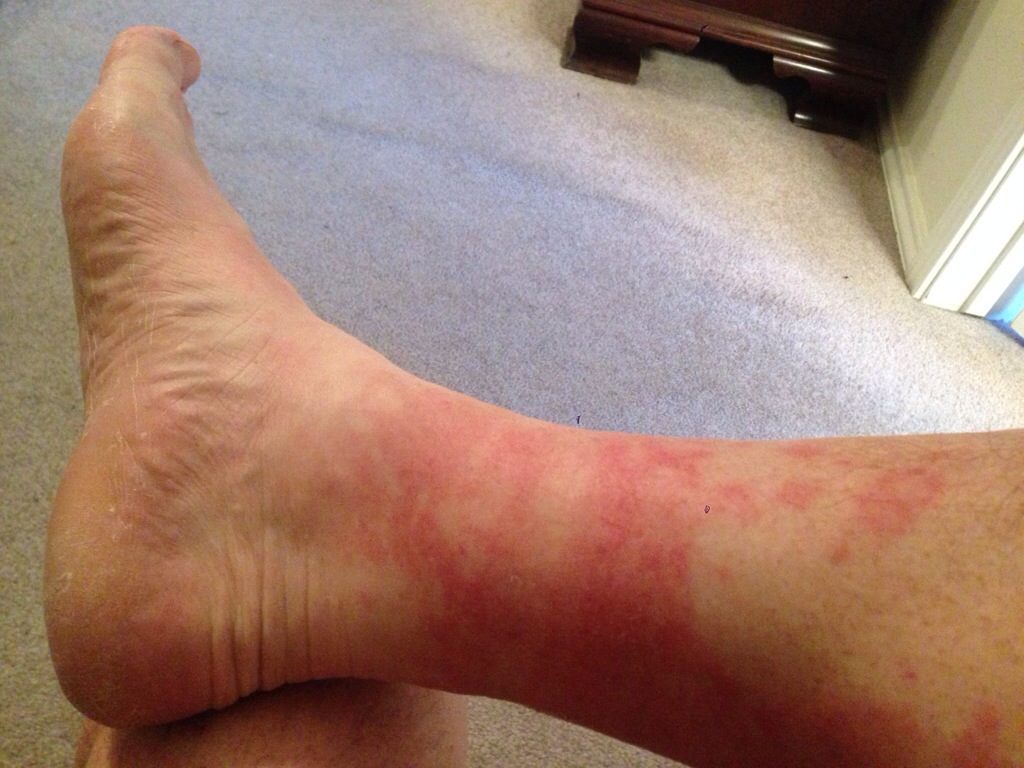Let’s say you’re on a trip to Disney World, sometime between May and September (a.k.a. “The Heat & Humidity Festival), visiting from your home where you don’t see the sun or warmth for half the year (or more). Or perhaps you’re on a golf vacation in the middle of the summer. Maybe you’re hiking or running in a really hot place and you’re not used to that kind of exercise in that kind of weather. Anyway, after a few days, you wake up one morning to find your legs are covered in a red splotchy rash.
What is it? Is it dangerous? What should you do about it?
Maybe you’ll search the internet to find out about it, and if so, hello and welcome to our page! Before anything, understand that you’re currently reading a travel blog, not a medical site. If you have a medical emergency, seek attention immediately and stop Googling your symptoms.
Otherwise, you might head to the local pharmacy to find out what you can buy to treat it. You’ll find out this is a pretty common problem for people visiting Florida or anywhere else that gets really hot.
You’ve come down with Disney Rash. Oh, it has plenty of other names too, like:
- Golfer’s Rash
- Hiker’s Rash
- Runner’s Rash
- Dollywood Rash
All of these names refer to the same condition: Exercise-Induced Vasculitis (EIV).
This condition is characterized by a telltale red rash that starts just above the sock line. There are many possible causes for the condition and just as many potential treatments.
Causes of Exercise-Induced Vasculitis
While the actual cause isn’t known, a reasonable explanation is that the rash is caused by increased physical exercise combined with heat.
Anyone who’s looked at their Fitbit or Apple Watch knows that walking around a theme park (or a golf course, etc.) for a day, or two or three, covers a bunch of steps. Walking several miles a day is not uncommon. Now ask yourself, how much do you usually walk in a day or a week? I’m guessing not as much, correct?
All of this increased exercise leads to fluid retention in the extremities; in other words, your legs swell. This extra fluid stretches out the small blood vessels in your legs. This irritation from the swelling in combination with the heat (not the sun, as many people think; you can get this kind of rash on a cloudy day) is the current explanation for the redness (which, by the way, is not truly a rash in the term’s medical sense. But that’s what people call it, so that’s what we’ll go with.).
If you think about it, this makes sense. Why does the redness happen just above the sock line? Because below that, your sock (and shoes) provide compression and prevent the blood vessels in those areas from getting swollen and irritated.

Treatment of Exercise-Induced Vasculitis
So now that we know what is the most likely cause of the redness of your legs, what can you do to treat it? Unlike some conditions, you just can’t put a cream on it or take a pill and make it go away. The redness will usually go away on its own in 7-10 days once you stop the activity that caused it to happen. In other words, it will go away when you go home and get back to your normal routine.
Now, if you want to help it clear up, there are some things you can do:
- Applying an over-the-counter Hydrocortisone cream can help if the area is itchy
- Staying hydrated (drinking plenty of water) might help and is good advice for anyone outside in the summer heat.
- Sitting with your legs elevated or putting cold towels over your legs can help reduce the swelling (edema) and irritation to the blood vessels.
Prevention of Exercise-Induced Vasculitis
So maybe you’ve suffered from this condition before, or you want to make sure this doesn’t happen to you on your vacation. What can you do?
Since this usually happens to people when they radically increase their physical activity, combined with the excessive heat, getting your body ready for the trip in advance may decrease the incidence of Golfer’s/Hiker’s/Runner’s/Dollywood/Disney Rash. Don’t expect your body to go from 0 to themepark/sports overnight. Even moderate exercise before the trip will prepare your body to deal with the increased physical activity you’ll experience when walking around the parks, the golf course, etc., for hours per day.
If you’re still concerned, wearing compression socks can help reduce the edema (swelling) of your legs and hopefully prevent getting the “rash” in the first place. They’ll also help keep your feet from swelling on the plane trip to/from your vacation location.
Watching what you eat can also help. One thing people tend to do when vacationing is forgetting to watch their diet. Increasing your salt intake (hello, popcorn carts and pretzels along with french fries/chips and hot dogs) can cause fluid retention, which is just the thing you want to avoid if you’re worried about getting vasculitis.
There’s also anecdotal evidence that anything from wearing sunscreen, massaging your legs during the day or taking a cool bath at the end of the day can help prevent symptoms.
I tend to say that people need to understand that if they put their body under increased stress, like a drastic increase in physical activity under extreme heat conditions, a physical presentation shouldn’t be unexpected. In other words, if you go walking five+ miles a day in 90+ degree heat, you shouldn’t be shocked that you break out into a “rash.”
Want to comment on this post? Great! Read this first to help ensure it gets approved.
Want to sponsor a post, write something for Your Mileage May Vary or put ads on our site? Click here for more info.
Like this post? Please share it! We have plenty more just like it and would love it if you decided to hang around and sign up to get emailed notifications of when we post.
Whether you’ve read our articles before or this is the first time you’re stopping by, we’re really glad you’re here and hope you come back to visit again!
This post first appeared on Your Mileage May Vary


6 comments
This is a good reminder to take it easy when you travel and don’t overdo it. It is better to miss out on one or two attractions than to get sick or injured and ruin the rest of your vacation.
WOW I thought I had cellulitis and been on antibiotics! I thought it was working until I got back to helping my friend move out of a house and bam it’s back and worse and was just fixing to go to the er! This makes way more sense then cellulitis being there is no open wound anywhere on my body! I spent 2 weeks in the hospital once and they never could find anything that was causing the cellulitis and now I’m almost certain this is what I’ve been dealing with the whole time!! Thank you so much for posting this!! This has made me feel way better and not so worried!!
Just be sure to check with a doctor if things don’t improve. This post wasn’t intended to be medical advice.
We used to see so much of this when I worked in Times Square. Especially with tourists from cooler/colder climates. Alternatively we DID also see a TON of cellulitis from mosquito bites. It seemed that Norther Europeans especially reacted really poorly to mosquito bites.
I just consider it part of the trip.
In
Just notice this rash, I am on my feet in a store walking all over 5hrs day with extreme heat temps here in florida.just pop up all of a sudden.no itch